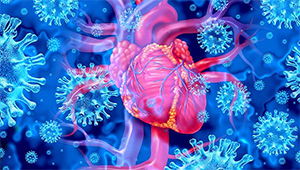AHA’s 2021 Top Picks: Headway Continues to Be Made Against CVD
Even during a pandemic, the AHA says, research on obesity, hypertension, diabetes, and more continues to pay dividends.

For the 26th year in a row, the American Heart Association (AHA) has released its annual list of “leading cardiovascular-related research accomplishments.” Much like last year, the look back at 2021 shows that COVID-19 news continued to capture headlines, though as the AHA makes clear, the knowledge base also grew more broadly for the prevention and treatment of CV disease. Here are the highlights.
1) Top of the list, the AHA says, is hope in the fight against obesity. This summer, the US Food and Drug Administration approved semaglutide (Ozempic; Novo Nordisk) for chronic weight management, with positive data coming from the STEP 1, STEP 3, and STEP 4 trials. The injectable glucagon-like peptide-1 (GLP-1) analogue previously had received the agency’s sign-off for glucose control and reduction of MACE in patients with type 2 diabetes. Additionally, new observational data published this spring in Circulation lend support to bariatric surgery by showing fewer MACE among patients with obesity and CV disease who underwent the procedure compared with those who didn’t have surgery.
 2) Another advancement comes by way of sodium-glucose cotransporter 2 (SGLT2) inhibitors, for which a growing evidence base supports the idea that, beyond glycemic control, the drugs offer CV benefits. SCORED and SOLOIST-WHF, which both made it into print in the New England Journal of Medicine this year, showed that sotagliflozin (Zynquista; Sanofi Aventis/Lexicon) reduces the risk of heart failure (HF)-related hospitalization in diabetic patients with chronic kidney disease (CKD) and those with decompensated HF, respectively. The EMPEROR-Preserved trial of empagliflozin (Jardiance; Boehringer Ingelheim/Eli Lilly) showed the SGLT2 inhibitor decreases CV death/HF hospitalization in patients with HF and preserved ejection fraction—regardless of diabetes status. As reported by TCTMD, the optimal strategy for using these medications in HF patients remains to be seen.
2) Another advancement comes by way of sodium-glucose cotransporter 2 (SGLT2) inhibitors, for which a growing evidence base supports the idea that, beyond glycemic control, the drugs offer CV benefits. SCORED and SOLOIST-WHF, which both made it into print in the New England Journal of Medicine this year, showed that sotagliflozin (Zynquista; Sanofi Aventis/Lexicon) reduces the risk of heart failure (HF)-related hospitalization in diabetic patients with chronic kidney disease (CKD) and those with decompensated HF, respectively. The EMPEROR-Preserved trial of empagliflozin (Jardiance; Boehringer Ingelheim/Eli Lilly) showed the SGLT2 inhibitor decreases CV death/HF hospitalization in patients with HF and preserved ejection fraction—regardless of diabetes status. As reported by TCTMD, the optimal strategy for using these medications in HF patients remains to be seen.
3) Better means of preventing harm from diabetes continue to gain traction, an AHA press release notes. “People with type 2 diabetes have at least double the risk of developing and dying from cardiovascular disease, and kidney disease is a common long-term complication.” Based on results from FIDELIO-DKD, midsummer the FDA approved finerenone (Kerendia; Bayer) for use in adults with CKD and type 2 diabetes to reduce the risk of kidney function decline, kidney failure, CV death, nonfatal heart attacks, and hospitalization for HF. Subsequently, the FIGARO-DKD trial provided positive data for the nonsteroidal, selective mineralocorticoid receptor antagonist in patients with type 2 diabetes and less-severe renal disease. The AHA also cites the AMPLITUDE-O trial showing benefits from efpeglenatide, a GLP-1 receptor agonist, in people with type 2 diabetes and a history of CVD or current kidney disease plus at least one other CV risk factor.
4) Taking a big-picture view, there was also progress in precision medicine as a tool for protecting the heart, the AHA notes, adding that it “could pave the way for new options in personalized medicine.” They point to the examples of early data in the New England Journal of Medicine and Circulation Research on gene editing to treat transthyretin amyloidosis and cardiomyopathy associated with Duchenne muscular dystrophy.
 5) Hypertension also is taking hits, as evidenced by several studies out of China. The Salt Substitute and Stroke Study, which spanned 600 rural villages and 20,995 participants, reported data showing a salt substitute (75% sodium chloride and 25% potassium chloride by mass) can be a simple, low-cost intervention in older adults with a history of stroke or high blood pressure. The salt stand-in lowered the risk of stroke by 14%, MACE by 13%, and all-cause mortality by 12%. Another trial, this one with around 8,500 hypertensive participants ages 60 to 80, showed that intensive treatment targeting a lower systolic BP level (110 to less than 130 mm Hg) could reduce CV events compared with standard treatment, the AHA points out. Additionally, as reported by TCTMD, the China Rural Hypertension Control Project released data at the AHA 2021 Scientific Sessions showing how an intervention delivered by village doctors—community health workers with basic medical training—in rural China resulted in a substantial jump in the number of hypertensive patients who achieved blood pressure control.
5) Hypertension also is taking hits, as evidenced by several studies out of China. The Salt Substitute and Stroke Study, which spanned 600 rural villages and 20,995 participants, reported data showing a salt substitute (75% sodium chloride and 25% potassium chloride by mass) can be a simple, low-cost intervention in older adults with a history of stroke or high blood pressure. The salt stand-in lowered the risk of stroke by 14%, MACE by 13%, and all-cause mortality by 12%. Another trial, this one with around 8,500 hypertensive participants ages 60 to 80, showed that intensive treatment targeting a lower systolic BP level (110 to less than 130 mm Hg) could reduce CV events compared with standard treatment, the AHA points out. Additionally, as reported by TCTMD, the China Rural Hypertension Control Project released data at the AHA 2021 Scientific Sessions showing how an intervention delivered by village doctors—community health workers with basic medical training—in rural China resulted in a substantial jump in the number of hypertensive patients who achieved blood pressure control.
 6) Also worthy of a close look, the AHA says, is the COVID-19 pandemic’s impact on the hearts of children and young adults. SARS-CoV-2, as described in a Circulation paper, itself can trigger multisystem inflammatory syndrome in children (MIS-C), which produces Kawasaki-like symptoms characterized by fever, abdominal pain, mucocutaneous disease, and often coronary dilation. Compared with Kawasaki disease, however, MIS-C patients tend to be older and face a higher frequency of cardiac complications like troponin elevations, cardiogenic shock, and reduced biventricular function, with striking similarities to the COVID-19 inflammation seen in adults. The good news is that most of these infrequent complications resolve within months. Additional good news relates to another pediatric COVID-19 concern: myocarditis after receipt of an mRNA vaccine. Back in July, the US Centers for Disease Control and Prevention said there’s a “likely association” between the two in adolescents and young adults, with most cases occurring shortly after the second dose and in males. Reassuring data have continued to accumulate over the course of 2021 indicating that the complication is extremely rare.
6) Also worthy of a close look, the AHA says, is the COVID-19 pandemic’s impact on the hearts of children and young adults. SARS-CoV-2, as described in a Circulation paper, itself can trigger multisystem inflammatory syndrome in children (MIS-C), which produces Kawasaki-like symptoms characterized by fever, abdominal pain, mucocutaneous disease, and often coronary dilation. Compared with Kawasaki disease, however, MIS-C patients tend to be older and face a higher frequency of cardiac complications like troponin elevations, cardiogenic shock, and reduced biventricular function, with striking similarities to the COVID-19 inflammation seen in adults. The good news is that most of these infrequent complications resolve within months. Additional good news relates to another pediatric COVID-19 concern: myocarditis after receipt of an mRNA vaccine. Back in July, the US Centers for Disease Control and Prevention said there’s a “likely association” between the two in adolescents and young adults, with most cases occurring shortly after the second dose and in males. Reassuring data have continued to accumulate over the course of 2021 indicating that the complication is extremely rare.
7) But COVID-19 vaccines aren’t the only shots with CV implications—influenza vaccines appear to protect the heart. In the Influenza Vaccination After Myocardial Infarction (IAMI) trial, presented at the European Society of Cardiology 2021 Congress and simultaneously published in Circulation this fall, patients who got a flu shot within 72 hours after experiencing an MI had a lower risk of all-cause mortality, MI, or stent thrombosis over the next year. “If there is a silver lining to this terrible year-and-a-half that everybody has suffered, I think it’s that the impact of respiratory tract infections on cardiovascular health is certainly propagated to the surface more than it ever has before,” Jacob Udell, MD (University of Toronto, Canada), commented to TCTMD at the time.
8) The adage “Time Is Brain” remained relevant in 2021, when research continued to show the need for speedy stroke care. Two studies, both reported by TCTMD, garnered AHA’s mention in their top picks. BEST-MSU, which took place in seven US cities, illustrated the potential for mobile stroke units—ambulances equipped with mobile CT and able to administer tissue plasminogen activator (tPA). Patients treated by them were more likely to receive tPA within the first “golden hour” after stroke and had better functional outcomes at 90 days. The Spain-based ANGIOCAT trial, on the other hand, showed that taking patients with large-vessel occlusions directly to the neuroangiography suite for endovascular therapy cut down on delays, increased the proportion of patients who received an intervention, and boosted 90-day functional outcomes. A third study, this one from New York, showed how mobile teams that travel to perform endovascular thrombectomy have the potential not only to hasten treatment for patients with large-vessel occlusion stroke but also to improve 90-day outcomes.
 9) Also noteworthy is CV disease during pregnancy, the AHA says, citing a study in the American Journal of Preventive Cardiology that found most US women had poor CV health before giving birth. This risk factor can carry consequences years down the line for their children, another study shows. Its lead author told TCTMD: “The mom's cardiovascular health levels during pregnancy need to be investigated a little bit further to see if improving them could help their kids avoid cardiovascular disease in the long run.”
9) Also noteworthy is CV disease during pregnancy, the AHA says, citing a study in the American Journal of Preventive Cardiology that found most US women had poor CV health before giving birth. This risk factor can carry consequences years down the line for their children, another study shows. Its lead author told TCTMD: “The mom's cardiovascular health levels during pregnancy need to be investigated a little bit further to see if improving them could help their kids avoid cardiovascular disease in the long run.”
10) The AHA press release also highlights studies that “continue to explore the appropriate dosage and length of time for using antiplatelet medicine.” MASTER DAPT, for instance, confirmed that for patients at high risk for bleeding, 1 month of dual antiplatelet therapy after PCI was noninferior to 3 months or more; the shorter time frame also cut the risk of bleeds. Registry data from Michigan, the AHA notes, show that for patients with atrial fibrillation or venous thromboembolism, aspirin added to direct oral anticoagulants upped the risk of bleeding and hospitalizations without decreasing the thrombosis rate.
11) And last but not least, the AHA pointed to the potential for a single “polypill” that tackles both cholesterol and blood pressure by combining a statin, ACE inhibitor, beta-blocker, and diuretic. Making it into print early this year was TIPS-3, a trial with a 2x2x2 factorial design testing the fixed-dose combination tablet. Alongside aspirin, the polypill significantly reduced the composite endpoint of CV-related death, MI, stroke, resuscitated cardiac arrest, HF, or revascularization by a relative 31% and absolute 1.7% compared with placebo. Without aspirin, there was an 11% relative reduction of borderline significance. TIPS-3 investigator Salim Yusuf, MD (McMaster University/Population Health Research Institute, Hamilton, Canada), speaking with the media during the 2020 AHA meeting when the data were first presented, stressed that not only poor countries stand to benefit. “We estimate that if half of people eligible to use the polypill—that is, half of the hypertensives and half of the diabetics—[used it], we would prevent 3 to 5 million cardiovascular disease events per year, with a quarter of them from rich countries. If the rich countries don’t want that benefit, that’s their prerogative,” he commented.
Caitlin E. Cox is News Editor of TCTMD and Associate Director, Editorial Content at the Cardiovascular Research Foundation. She produces the…
Read Full BioSources
American Heart Association. AHA names top heart disease and stroke research advances of 2021. Published on: December 16, 2021. Accessed on: December 28, 2021.





Comments